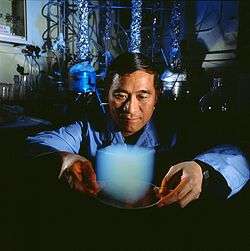Peter Tsou

Peter Tsou is a principal science staff member at the Jet Propulsion Laboratory (JPL) of the California Institute of Technology, where he has worked for the past 34 years.[1]
Dr. Tsou's area of focus is utilizing aerogel for space exploration.
Dr. Tsou is a Principal Investigator (PI) for a number of Shuttle and Mir missions, and is responsible for inventing the technique of intact capture of hypervelocity particles. In addition, his work revolutionized the use of silica aerogel for space missions. He is most famous for his work involving the capture and return of comet particles via NASA's STARDUST mission, to which Dr. Tsou served as deputy PI.
Education
Dr. Tsou was educated at the University of California, Berkeley, where he earned both his B.S. (1965) and M.S. (1966) in Electrical Engineering. He received his PhD in Large Scale Engineering Systems from the University of California, Los Angeles, in 1972.
Professional Experience
Since 1974, Dr. Tsou has worked at NASA's Jet Propulsion Laboratory, located in Pasadena, CA. He has been involved in multiple projects, most recently as Deputy Principal Investigator (PI) of STARDUST (1994–present). Prior to this, Dr. Tsou served as PI for the MIR Sample Return Experiment (1994–1997), PI for Spacehab II Sample Return Experiment and STARDUST proposal manager (1992–1994), PI for Get Away Special Sample Return Experiment (1989–Present), instrument definition manager (1984–1990), spacecraft system engineer (1982–1990), Task Manager for the Low Cost Solar Array program (1975–1980), and a system engineer (1974–1975).
Prior to his work at JPL, Dr. Tsou worked at University of California, Los Angeles, as a project manager on the Climate Impact Assessment Program of the Supersonic Transport (1970–1974), and at TRW as a technical staff member (1966–1968).
Dr. Tsou has won several NASA awards, including the NASA Patent: Large Field of View 3-D Hologram Display System (2000), NASA Group Achievement Award - STARDUST Project Team (2000), NASA Exceptional Achievement Medal (1997), JPL Inaugural Award for Excellence - Exceptional Technical Excellence (1996), and the NASA Group Achievement Award - Low Cost Solar Array Project (1985).
Technical Papers
During his career, Dr. Tsou has authored and co-authored more than 60 technical papers. Some selected samples:
Tsou, P., F. Giovane, J-C. Liou, R. Corsaro. “Large Area Dust Collection – on the International Space Station”, 2007.
Tsou, P., D. E. Brownlee, R. Glesias, C. P. Grigoropoulos, M. Weschler, “Cutting Silica Aerogel for Particle Extraction”, 36th LPSC, 2307, 2005.
Tsou, P., "Cosmic Dust Intact Capture Experiment", STAIF-99, 1999.
Tsou, P., "Hypervelocity Capture of Meteoroids in Aerogel", ASPCS Vol 104, 237-242, 1996.
Tsou P. & Albee A. L., “Comet Flyby Sample Return", AIAA-85-0465, 1985.
Research
His research interests for the past two decades have concentrated on achieving a sample return of cometary coma material. He invented the technique of intact capture of hypervelocity particles for just such a mission as Stardust, the 13th proposal for a comet flyby sample return mission. Working with scientists at Lawrence Livermore National Laboratory, he made the aerogel material lighter and more suitable for catching the comet particles.[2] He has also introduced the use of aerogel as one of the capture media and flight qualified variable density aerogel for space flight.
He is the principal investigator for a series of Shuttle Sample Return Experiments and Mir Sample Return Experiment with silica aerogel he made at JPL. He continues to develop improved techniques to identify, remove and study particles captured in aerogel.
Dr. Tsou was responsible for inventing an integrated aerogel thermal-structural design for the Mars Pathfinder Sojourner Rover, another breakthrough for space thermal insulation.[3]
Miscellaneous
Dr. Tsou has donated several samples of aerogel for display at JPL's museum, located on their main campus in Pasadena, CA.
Dr. Tsou donated a piece of aerogel to the Kirkpatrick Science & Air Space Museum, also known as the Omniplex Science Center, for the first public display of the traveling "Stardust Cafe" exhibit.
In 2009, Dr. Tsou donated a sample of space-grade aerogel to Santa Monica College for display in their science complex, with the goal of inspiring more students into the sciences.
Quotes
"It's a perfect landing [...] we are jumping and applauding. I can hardly sleep. Nevertheless I had been waiting 25 years before this night." (Concerning the Stardust project)
"It has rounded the Sun for just 5 circles, that means, most of its materials are well kept at a pristine state 4.5 billion years ago." (Concerning the Stardust project)
"Aerogel has several unique properties that can provide many useful terrestrial applications."
"...aerogel has many unique properties that [are] very suitable for space missions and to collect comet particles."
"Stardust is the realization of a 25-year dream to capture and return samples from a comet."
"STARDUST, together with other planetary missions, has contributed to our increasing understanding of our past and it will continue to inspire our dreams for the future."[3]
"Perhaps for those who dream grand dreams of space exploration to come, this may provide some inspiration in pursuit of such quests and offer suggestions for success in even more extraordinary space explorations in the near future."[3]
References
- ↑ "Bios - Dr. Peter Tsou". NASA. Retrieved 2006-05-11.
- ↑ Irion, Robert (October 2003). "To Catch a Comet". Discover.
- 1 2 3 Tsou, P., “STARDUST: a Comet Coma Flyby Sample Return”, IEEE, 2009.